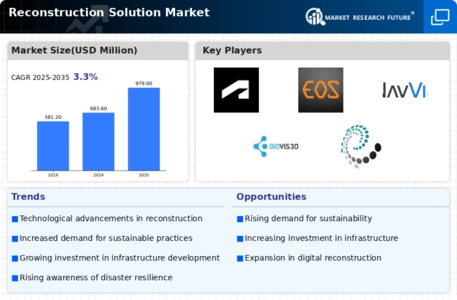Top Industry Leaders in the Reconstruction Solution Market

The reconstruction solution market, encompassing software and services used to rebuild infrastructure, environment, and communities after disasters or accidents, is a dynamic and complex space. it attracts diverse players vying for market share. Let's delve into the competitive landscape, explore key strategies, and analyze recent developments:
Strategies for Success:
-
Technology Focus: Integrating cutting-edge technologies like AI, machine learning, and 3D modeling into reconstruction solutions is crucial. Companies like RSIP Vision with AI-powered medical imaging reconstruction and Skyline Software Systems with 3D visualization tools are frontrunners in this area. -
Specialization: Focusing on specific areas like disaster management, infrastructure repair, or environmental restoration caters to niche needs and fosters expertise. Trimble Inc.'s LandWorks for construction and Arcadis' environmental consulting services exemplify this approach. -
Sustainability Integration: Emphasizing green solutions and materials for resilient reconstruction resonates with environmentally conscious clients. CEMEX's Vertua line of sustainable building materials and Saint-Gobain's Ecodesign approach are prime examples. -
Partnerships and Acquisitions: Collaborating with local construction companies, government agencies, and NGOs can expand reach and expertise. Recent acquisitions like Bentley Systems acquiring Acute3D for 3D reality capture demonstrate this trend. -
Data-Driven Insights: Leveraging data analytics to optimize reconstruction processes, predict future risks, and improve resource allocation is becoming increasingly important. Companies like Esri with its ArcGIS platform and Bentley Systems' iTwin platform are at the forefront.
Factors Influencing Market Share:
-
Market Segment: The market is segmented by solution type (software, services), end-user industry (infrastructure, environment, disaster management), and region. Each segment has its own growth drivers and competitive dynamics. -
Government Initiatives: Government investments in infrastructure resilience and disaster preparedness can significantly impact market demand. For instance, the US Infrastructure Investment and Jobs Act is expected to boost construction and reconstruction spending. -
Natural Disasters: The frequency and intensity of natural disasters are unfortunately rising, leading to increased demand for reconstruction solutions. Companies with proven track records in disaster response gain an edge. -
Technological Advancements: Continuously improving technologies like robotics, drones, and advanced materials offer new opportunities for faster and more efficient reconstruction. Early adopters of these technologies have a competitive advantage.
Key Companies in the reconstruction solution market include
-
Autodesk Inc.
-
EOS imaging
-
NavVis
-
Pix4D SA
-
Bentley Systems
-
Incorporated
-
Skyline Software Systems Inc.
-
3DHISTECH Ltd.
-
BioVis3D
-
Reconstruct Me
-
ELCOVISION 10
Recent Developments:
November 2023: The World Bank announces a USD 1 billion investment in disaster-resilient infrastructure in developing countries, creating opportunities for reconstruction solution providers.
December 2023: A devastating earthquake in Turkey highlights the need for rapid and efficient reconstruction solutions, leading to increased demand in the region.
January 2024: A consortium led by AECOM and Stantec wins a major contract for the reconstruction of flood-damaged infrastructure in California, showcasing the importance of collaborative partnerships in large-scale projects.









